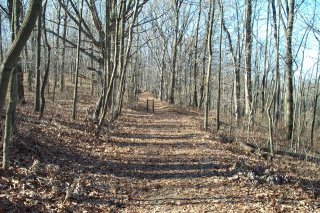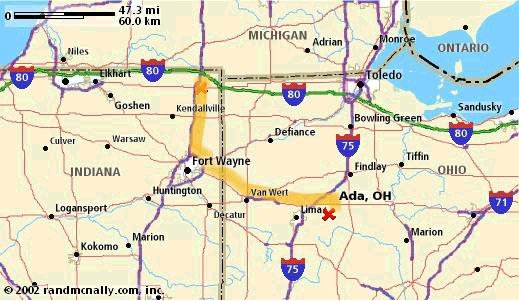
to
Pokagon
"Effort and Creativity"
All of the photos you see on these pages were taken by two of my students, Geoff Carr and Matt Valerio. The photos were taken at Pokagon State Park. The map below gives some indication as to the length of the "road trip" (about 125 miles to get there) that they and a couple other students undertook:

Matt and Geoff decided that they wanted to do something "interesting," so they implemented a GUI version of "Escape to Pokagon" using MFC! Definitely an eye-opening experience for two students just finishing their second programming course. They asked me for assistance, and I provided them with Deitel & Deitel "Getting Started with Microsoft Visual C++ 6 with an Introduction to MFC." Later, they informed me that the book gave them enough background to know the basics and what questions to ask for the more advanced items. To quote Matt, "It's a whole different world... we have learned an incredible amount of material just by doing it." They consulted with one of our CS seniors and our resident Microsoft guru on the faculty... and decided to surprise me by taking the road trip and getting actual photos of Pokagon. At each "room" they took either four or six photos - one in each direction. The result was just incredible - as you can see for yourself from this screenshot. The extras were not limited to the pictures. A verb data file was implemented for the customization of advanced actions, such as 'USE BINOCULARS' or 'START FIRE', that would be inappropriate to include in the source code of an adventure engine. A message data file was also implemented, partially in conjunction with the extended verb list. To see a different approach at formatting the data files, please refer to Geoff and Matt's documentation for their data files - either in MS Word (26 KB) or Adobe PDF (114 KB) format.
My students learned a lot from this assignment, and I learned a great deal about my students in the process. To quote one of my students:
| I think this is a pretty in-depth program. I've worked hard on this project over the past three weeks, and it has culimated into a project I am proud to have created on my own. This has been a tremendous learning experience, and I think I am on the road to mastery of the C++ we have learned so far. Before this project I felt like I was floundering in the programming and programmer-community, but now I am confident of the skills I know and look forward to learning more about the language as well as other languages. |
Return back to Pokagon...
Follow the twisty link back to the nifty adventure assignment....